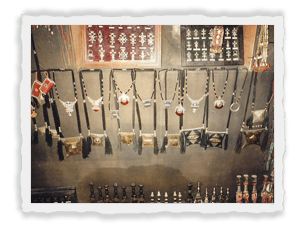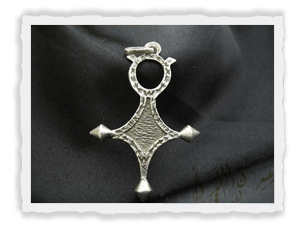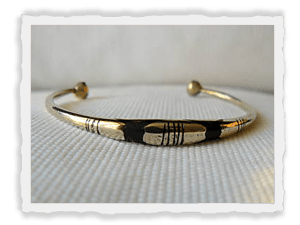

A unique aspect of Touaregs handicraft is the production of silver jewellery that has been in place since ancient times. Touareg women have a superstitious fear of gold: they never wear it! Silver has therefore replaced gold in Touareg traditions.
Silver jewellery holds a place in each Touareg family’s heritage. The production of jewellery not only has symbolic value, but also an economical importance as it constitutes the sole income for many families.
Each piece of jewellery is a message that bears an often-forgotten symbol.
Each necklace worn by a Touareg woman evokes diverse historical anecdotes of a people, a region, and a town.
 The pendant:
The pendant:
The pendant often represents the Sultan’s palace:
One also finds diverse symbols of man, woman and pregnancy, as well as birth.

The Southern/South Cross:
The Southern Cross, or the Croix d'Agadez or d'Iferwan, was formerly worn exclusively by men and was passed down from father to son upon reaching puberty. The Southern Cross refers to the young man’s virility and his nomadic tradition. The handing down is traditionally where the father recites the following eternal phrase to his son:
"My son, I give you the four directions of the world, because you never know where you will go to die".
There are twenty one different crosses associated with twenty one towns, villages or tribes in Niger. The cross represents the handle of a camel’s saddle or the four cardinal leaders.

The composition of the Silver:
Silver is the main base metal for the jewellery. It is cut with other metals because silver, just like gold, is too soft and malleable to be used pure. It is therefore Silver 925/1000 (that contains 92,5% pure silver). The Touaregs do not generally have hallmarks, especially in Niger. Instead of a hallmark, they often sign their jewellery with their name using the tifinagh alphabet.
And so, we respect the following conditions: